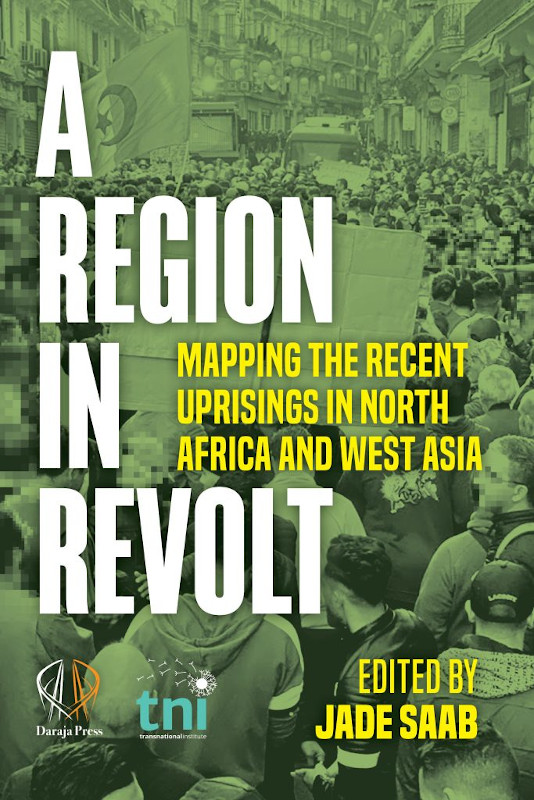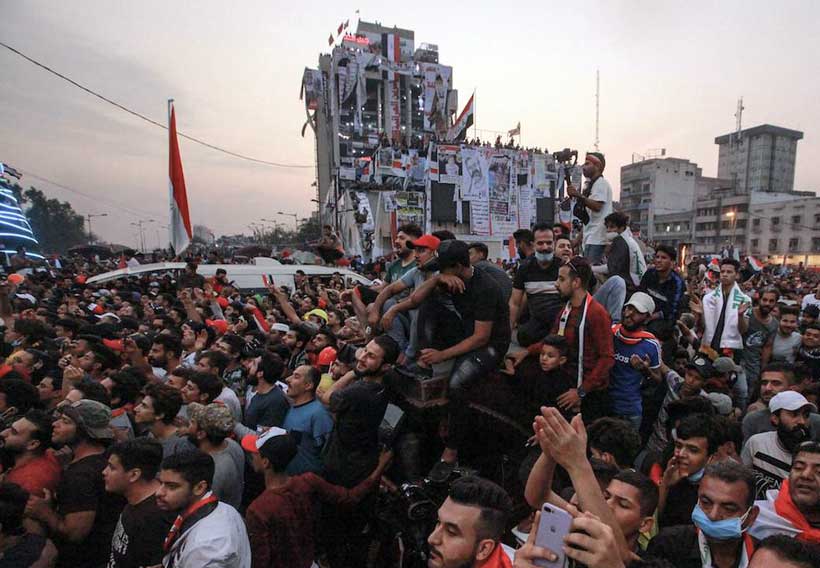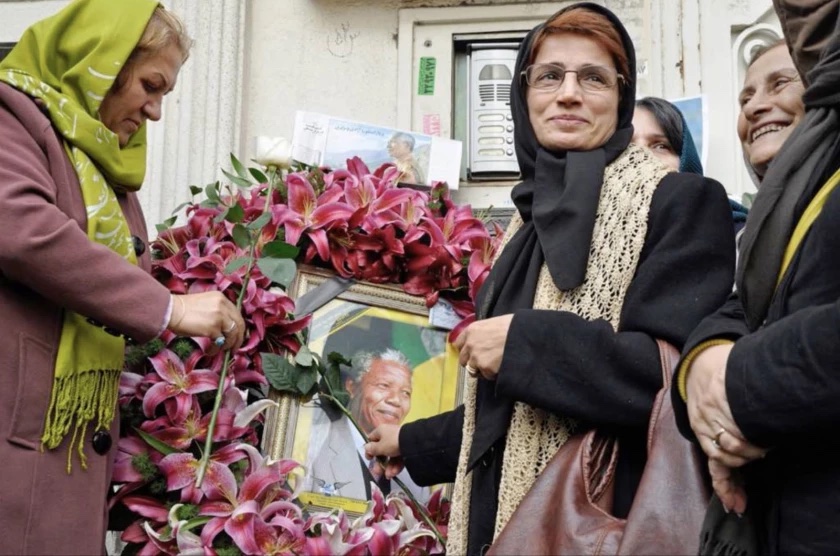Iran’s Bloody November

A region in revolt
Mapping the recent uprisings in North Africa and West Asia
by Jade Saab (Editor)
Daraja Press, 2020

Sam Salour summarizes A Region in Revolt: Mapping the Recent Uprisings in North Africa and West Asia edited by Jade Saab, a collection of essays that provides a comprehensive review of the 2018-2019 wave of struggle in the region. In the third part of this multi-part series, Salour provides an introduction to the book and then outlines the essay “Iraq’s October Uprising: Historical Context, Triggers, Discourse, Challenges, Possibilities” by Zeidon Alkinani.
Starting in 2018, a wave of revolutionary uprisings swept over the region commonly referred to as the Middle East and North Africa. Protesters in Sudan, Algeria, Iraq, Lebanon, and Iran took to the streets to demand the overthrow of their respective authoritarian regimes. While recognizing the common characteristics of these protests, the essays collected in the book A Region in Revolt: Mapping the Recent Uprisings in North Africa and West Asia emphasize the specific historical, political, and economic contexts of each country, highlighting the key actors involved, their goals, their weaknesses, and their possibilities.

The economies of the region—in the absence of a developed manufacturing sector—rely on oil and gas exports. The wealth extracted from natural resources is distributed amongst corrupt elites and military apparatuses, while the domestic markets are opened up to the cheap goods of industrialized nations. Speculative adventures in real estate and banking siphon off capital, paralyzing domestic productive investment. The consequence for the vast majority of the population has been unemployment, marginalization, and poverty. These economic realities, along with the climate of corruption, political repression, oppression of women, and discrimination against minorities, created pre-revolutionary conditions in the region as a whole. Although all of these movements are revolutionary in their aspirations—demanding systemic change—it remains to be seen whether any of them can achieve revolutionary outcomes.
The movements in Algeria, Iraq, Lebanon, and Iran have been characterized by oppositional protests and the rejection of ruling elites, but have not been able to unite behind a set of positive demands. While the lack of leadership has prevented the co-optation of the movements by existing political parties, it has also hampered their further development. In November of 2019, mass protests erupted in Iran over an increase in fuel prices. The government responded with violence, arresting 7000 protesters and killing 200. Unlike the uprising in 2009, this revolt was led by the working class, spread beyond major cities, and had demands that went beyond reforms with calls for the overthrow of the regime. The 2019 popular uprising in Iran was inspired by and inspired other regional revolts. A new president, Ebrahim Raisi, was elected last month, but this conservative leader is unlikely to address the deep rooted crises.
The authors of the collection emphasize the importance of regional and international solidarity against the powers of international finance. While the struggle against imperialism and global capital does not imply defending reactionary regimes such as the Islamic Republic of Iran as the lesser evil, it does require a revolutionary vision that goes beyond overthrowing national authoritarian regimes. Although the different uprisings have shown awareness of the global setting of their struggle and the need for regional solidarity, concrete instances of collaboration are yet to come. It is the role of the global Left to help create the space for practical solidarity between movements.
Most of the essays in this collection are written by members of the Alliance of Middle Eastern and North African Socialists. The Alliance originally started in March 2016 as a grouping of Syrian and Iranian Socialists with a trilingual website (English/Arabic/Persian) to help express the aspirations of “the Other Middle East” to offer analyses of critical issues, host new conversations, and build bonds of solidarity between Syrians and Iranians opposed to their respective authoritarian regimes. Since then, the Alliance has grown to include members in all the countries covered in this collection (and others) while continuing its mission to provide and amplify socialist perspectives from the region.
Iran in revolt
In November 2019, over 200,000 Iranians, predominantly unemployed and student youth, took to the streets to protest the government’s 300 percent rise in petroleum prices. Protestors blocked streets and highways, set fire to police stations, banks, public buildings and religious seminaries, and burnt down posters of Ayatollah Khamenei, the Supreme Leader. They demanded the overthrow of the entire regime, shouting “death to the Islamic Republic” and “The Supreme Leader lives like a god. We the people live like beggars”.
The government shut down internet access across the country and unleashed its security forces who shot at protestors with the intent to kill. According to Reuters, throughout the country, over 1500 protesters were killed and more than 7000 arrested in a matter of days. Two months later, the government mistakenly downed a UIA flight from Tehran to Kyiv—killing all 176 passengers and crew on board in retaliation to the U.S. assassination of General Qassem Soleimani.
On January 11, 2020, the Islamic Revolutionary Guard Corps (IRGC) denied all claims that its missile had hit the plane. In response, students in Tehran and across the country protested, calling for an end to the Islamic Republic and the IRGC. The Association of Iranian Retirees’ issued a statement against how “human lives are sacrificed for the political goals and deals of the ruling system.” Many artists boycotted the state-sponsored annual Fajr film and music festival as a form of renouncing the government. Nevertheless, the oppressive apparatus of the state embodied in the IRGC immediately took control of the streets. The spread of COVID-19 also diminished the wave of protests.
Similar to the other regional uprisings, the November and January explosions were not spontaneous acts, but the culmination of years of protest and struggle against the regime and for better living conditions. Although the Iranian population has been suffering from sanctions imposed by the Trump administration, Frieda Afary emphasizes that the root cause of the political, economic, and social crisis engulfing Iran is the militarized, theocratic, state-capitalist regime that has ruled the country since the 1979 revolution and drained the country’s resources for its own imperialist adventures in neighboring countries like Syria, Iraq, Lebanon, and Yemen, while using an anti-imperialist discourse to quell internal opposition and co-opt part of the Left.
The government of Hassan Rouhani notwithstanding, Iran’s de facto state is constituted by the Islamic Revolutionary Guard Corps (IRGC)—under the direction of Supreme Leader Ayatollah Khamenei—which controls 80 percent of the economy. IRGC as a force represses women, youth, labor, and oppressed minorities inside Iran, while carrying out Iran’s military adventures in the region either directly or indirectly through Hezbollah militias funded by the Iranian state. In the meantime, 60 percent of the people are unemployed and up to 90 percent of workers have insecure, temporary contracts and are working without any rights or benefits. This has resulted in 60 percent of the population living below the poverty line.
Over the past few years, Iran has seen acute class struggle. In 2018 and 2019 there were strikes by truck drivers, teachers, railway workers, and healthcare workers amongst others. In Ahvaz, a strike of 4000 steel workers led to marches around the city by workers and their family members facing off with the police. Workers have been protesting the non-payment of wages, lack of health insurance and job security, and the privatization of government owned enterprises. The government has ignored their demands, severely repressed the protests, and continues to ‘privatize’ companies by handing them to contractors that are under the control of the IRGC. Labor leaders are consistently arrested, tortured, flogged, and portrayed as foreign agents.
The Iranian state has been hostile to provinces with majority Kurds, Arabs, and other national minorities. They are not allowed to use their mother tongue as the official language of instruction and administration and are routinely subjected to oppression and discrimination. The regime’s hostility towards the Kurds goes back to 1979, when Kurds who had supported the revolution were brutally suppressed, with hundreds executed for demanding their right to self-determination. To this day the regime remains fearful of the struggles in Iranian Kurdistan. In 2010, Farzad Kamangar, a young beloved teacher, journalist, and human activist, was executed by the regime. Despite mass strikes in Kurdistan against the execution of political prisoners, the regime executed a number of Kurdish political prisoners including Ramin Hossein Panahi and Zaniar and Loghman Moradi.
Although women represent 60 percent of university students and play a large part in the economic, political, and cultural life of the Iranian society, they are treated as second-class citizens and routinely face discrimination and violence both at home and at work. From its beginning, the Islamic regime used patriarchy and chauvinism to solidify its position amongst large sectors of men and conservative women. While promising the ‘rule of the oppressed,’ the Islamic regime made a hijab necessary, expanded sigheh or temporary marriage (a form of legal prostitution), and abolished the limited rights women had gained under the Shah.
Nevertheless, despite 40 years of repression, women continue to be at the forefront of struggles. Perhaps most emblematic has been the unwavering commitment of Nasrin Sotoudeh–a lawyer, activist, and one of the most beloved faces in Iran–who, in the face of continued intimidation and imprisonment, has sacrificed everything to defend the rights of women and political prisoners. There has been a resurgence of feminist struggles since Vida Movahed, in December 2017, stood on a utility box in Tehran’s Enghelab (Revolution) street, took off her white headscarf (hijab) and waved it on a stick for everyone to see. This was truly a heroic act considering that the punishment for not wearing a hijab is flogging and imprisonment. Since then, hundreds have been arrested repeating her defiant act.
For decades, Iranian students have been playing a significant role in progressive and revolutionary struggles. Although the main engine of the 1979 revolution, they were harshly repressed by the Islamic regime in the ‘cultural revolution’ of the early 1980s when thousands of Leftist academics and students were arrested and executed by the regime. Students played an important role in radicalizing the mass protests of December 2017 and November 2019 and initiated the January 2020 protests against the IRGC’s downing of the UIA flight. By establishing accessible journals and communication platforms, students have been playing a central role in connecting the struggles of national minorities, women, formal and marginalized workers. One example was the online journal Gam (Step), founded in 2016, it covered cultural and political issues from a socialist perspective and provided live coverage of labor actions and protests across the country. However, the journal has been dormant since July 2019 when all the members of its editorial board were arrested. A symbol of the student movement is the 33-year old PhD student Yashar Darolshafa. Despite twice imprisonment and constant intimidation, he passionately and courageously continues to fight for the oppressed.

While individuals such as Nasrin Sotoudeh, Mohammad Habibi, and Yashar Darolshafa are highly influential, the popular revolt has no leaders. Reactionary groups such as monarchists (supporters of Reza Pahlavi, the son of the former Shah), secular nationalist, and Mojahedin Khalq—a militarist cult funded by the US government—have been using this vacuum to appeal to the people. Mojahedin are largely discredited, but the popularity of monarchists, and particularly the secular nationalists who are promising bourgeois democracy along with an efficient capitalist economy, is growing. These are nothing but illusory promises, however, Afary warns that in the absence of a socialist humanist, and revolutionary alternative to the inhumanity of capitalism, misogyny, racial, ethnic and religious prejudice, they may grow in popularity inside Iran.
Instead of opposing the oppression of the Iranian regime, many socialists have adopted the logic of ‘lesser-evilism,’ supporting the narrow ‘anti-imperialism’ of the Islamic regime. Afary calls on the U.S. and the global Left to abandon this selective ‘anti-imperialism’ standpoint and project a socialist vision that unapologetically takes the standpoint of the oppressed everywhere in the struggle for human emancipation. The Left has a responsibility to hold Iran’s brutal regime accountable, call for the release of thousands of political prisoners, and uplift the demands of feminists, labor activists, and oppressed minorities. Caught between the Islamic regime and western imperialism, they deserve our support. International solidarity, not siding with the lesser oppressor, is our only hope.
Featured Image Credit: Wikimedia Commons. Modified by Tempest
Categories
We want to hear what you think. Contact us at editors@tempestmag.org.
Sam Salour View All
Sam Salour is a writer and activist in New York City. He is a member of DSA and the Tempest Collective.
